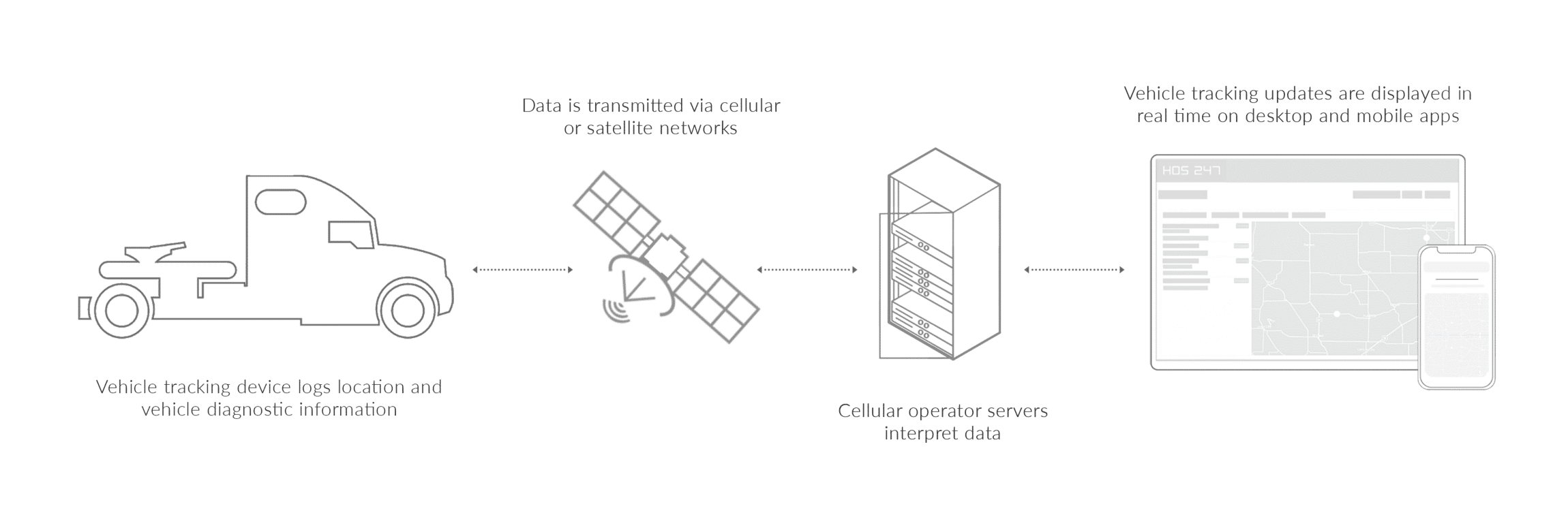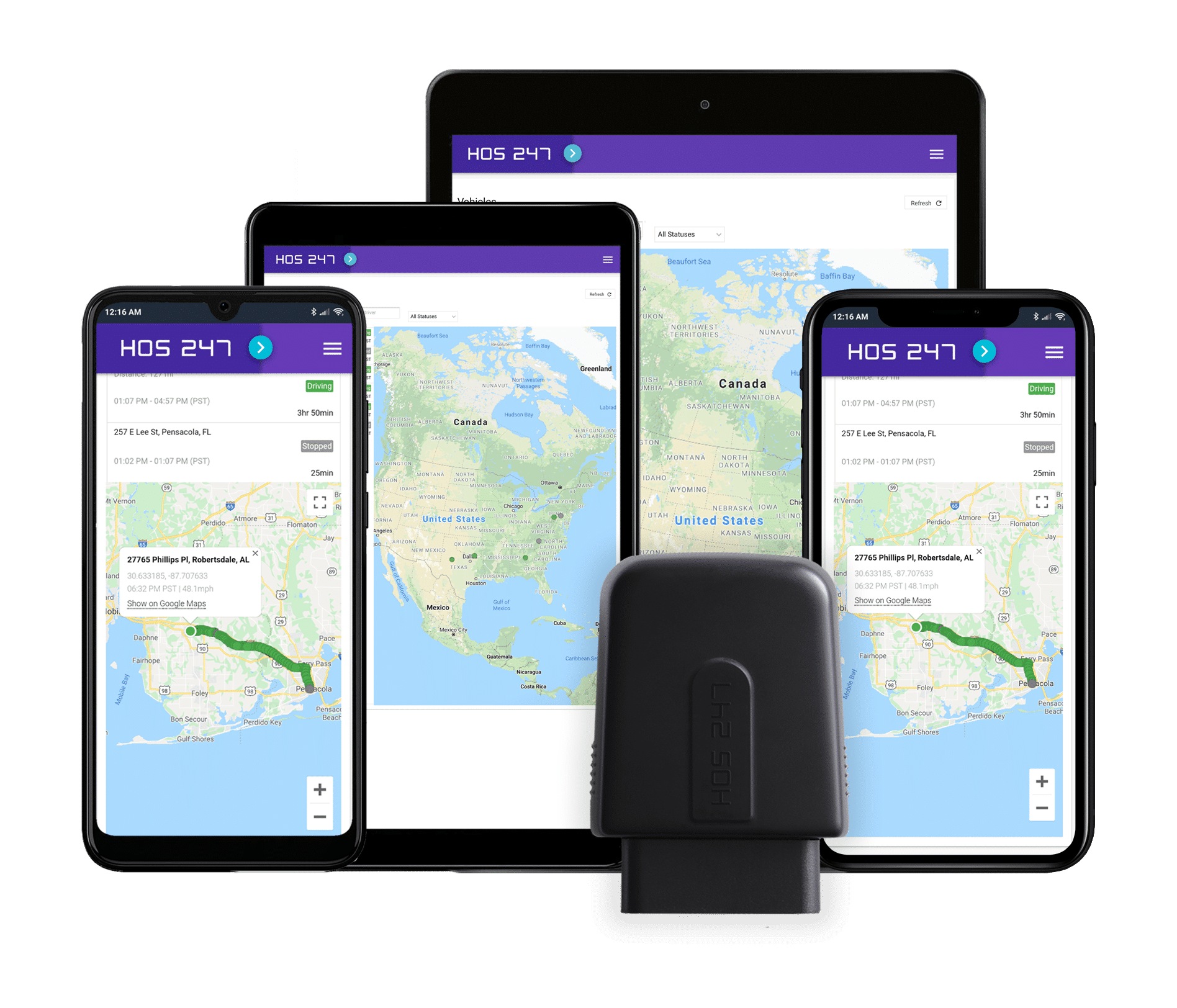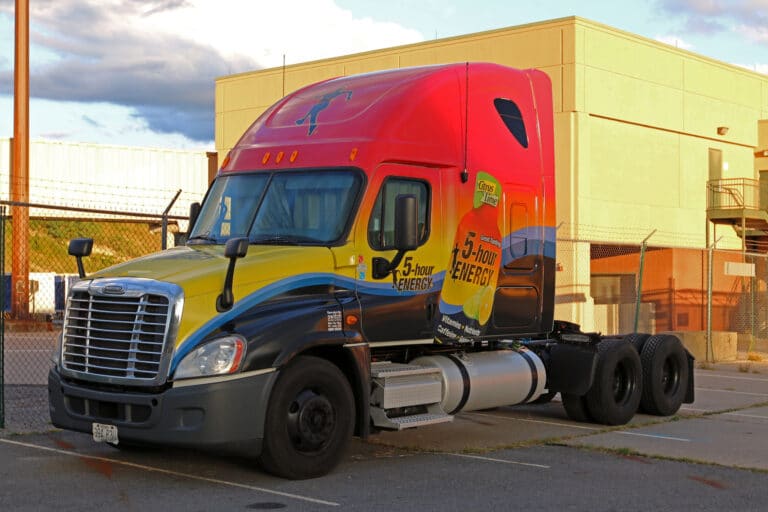For truck owners and carrier companies, logistics is always a priority. This is where real-time tracking of commercial vehicles can offer multiple benefits, including increased productivity and enhanced security. Before going into the advantage of live truck tracking in detail and how to choose the right option for your operations, let’s review how these systems work.
Do you have any questions? Talk to ELD Advisor: 650-405-3372 or Request Callback
Functioning of Tracking Devices
Live truck tracking systems use GPS technology to monitor the real-time location of vehicles. Electronic devices installed in truck or semi trucks collect this and other information and transmit it wirelessly to servers. Advanced tracking devices can integrate with an electronic logging system to record HOS data along with speed and diagnostics. The collected data is then analyzed and reflected on the fleet manager portal to help them identify areas of opportunity and improve operations.

Real-Time Tracking vs. Periodic Updates
Fleet managers must choose between real-time and periodic tracking updates, a decision that impacts both operations and budget.
Periodic tracking systems update locations every 15-30 minutes, while real-time systems like HOS247 update every 30 seconds to 2 minutes. This difference becomes critical during customer service calls – with periodic updates, you’re working with outdated information, but real-time tracking provides current locations for accurate ETAs.
4G/5G Network Advantages
Modern 4G networks transmit data 100 times faster than 3G systems, ensuring instant updates even in areas with moderate signal strength. These networks handle multiple data streams simultaneously – location, diagnostics, and driver metrics. Systems using 4G will seamlessly transition to 5G networks, future-proofing your investment. The improved bandwidth maintains consistent connectivity across rural trucking corridors where older systems might lose signal and create data gaps.
Battery Life and Data Considerations
Real-time tracking consumes more resources than periodic systems. Monthly data usage runs 50-100 MB per vehicle for real-time versus 10-20 MB for periodic updates – a difference of about $5-10 monthly. Modern devices include smart power management that adjusts consumption based on vehicle activity. Hardwired systems draw vehicle power directly, while battery units now last weeks between charges thanks to improved technology.
Making the Cost Decision
Real-time systems cost 20-30% more upfront but often deliver ROI within one year through:
- Operational efficiency. Better routing and reduced idle time.
- Insurance savings. Many insurers offer 5-15% discounts for continuous monitoring.
- Billing accuracy. Proper documentation for accessorial charges.
- Customer satisfaction. Accurate delivery windows reduce complaints by 25%.
The choice depends on your operation’s specific needs – high-value loads and time-sensitive deliveries justify real-time investment, while less critical operations might suffice with periodic updates.
Benefits of Using a Live Truck Tracking System
Efficient fleet management is a key element for successful trucking operations. Trackers are an effective way for the carrier’s staff to have full visibility of the vehicles and their everyday operations. Here is a list of advantages of using GPS tracking:
- Fuel savings. Tracking systems detect risky driving patterns helping fleet managers to improve drivers’ behavior, raise awareness about fuel consumption and lower operational costs.
- Enhanced security. Live truck tracking considerably increases driver and vehicle security, notifying staff via the fleet manager portal in case the vehicle is driven at unregistered locations or has been involved in an accident.
- Recovery of stolen assets. Live GPS data helps locate stolen vehicles so they can be tracked and recovered, minimizing financial losses.
- Lower insurance premiums. The increased security offered by trackers minimizes the operation’s risk. Insurance companies recognize this and offer lower insurance premiums to carriers that implement these systems.
- Better customer relationships. Loads are safer and easily located at any time, allowing managers to better plan deliveries and provide more accurate information to clients.
- Lower maintenance costs. Preventative vehicle maintenance features in live truck tracking systems help keep the fleet in top shape. Along with eliminating risky driving, fuel wastage, and misuse of vehicles, this feature prolongs the trucks’ useful lifespan and maximizes the carrier’s investment.
- Reduce administrative burden. Tasks are automated and paperwork is reduced. Also, the staff has real time information to allow better and timely decision making.
With benefits spanning from fuel savings to enhanced security, live truck tracking has become essential for competitive fleet operations. For carriers serious about efficiency and profitability, implementing a reliable GPS tracking system isn’t just an option – it’s a necessity.

Choosing a Live Truck Tracking System
With so many brands selling GPS trackers, it can be confusing to choose the one that meets your business’s requirements. Several factors should be considered to find a reliable device, including:
- Electronic logbook option. For fleets operating in interstate commerce, it can be useful to purchase a single system with GPS and ELD functions to facilitate compliance with the FMCSA-enforced mandate.
- Compatible hardware. A fleet might have anything from semi trucks to pickups. The tracker should integrate with all these vehicles to save the carrier the trouble of finding a different provider for each vehicle type.
- Easy installation. With fast and easy installation, truckers can avoid downtime and in some cases, additional costs too. Find a device that can be installed promptly and starts operating immediately when switched on.
- User-friendly operation. Any complicated system will discourage fleet managers or prevent them from implementing it correctly, affecting fleet efficiency and productivity.
- Real-time data. Many trackers are designed to offer periodic updates on the location of the vehicle. This means fleet managers will see the location of the vehicle only a fixed number of times per day. However, depending on how much visibility they need, carriers might prefer a live truck tracker that continuously monitors their vehicles.
- 4G supported. 4G networks are faster, provide more reliable data transmission and will also be compatible with 5G.
- Trial period. Only confident providers allow potential a trial period before purchasing their product. Look for such providers to test the system’s performance before making an investment.
These factors – from ELD integration to real-time data capabilities – separate basic trackers from comprehensive fleet management solutions. By prioritizing these features and avoiding providers with rigid contracts or hidden fees, carriers can select a system that delivers immediate value while scaling with their business growth.
Reasons to Choose HOS247 4G Fleet GPS Tracking System
HOS247 has been catering to truckers and fleet owners for quite some time. The brand has earned a reputation for offering highly reliable ELDs and fleet management systems like GPS trackers. HOS247 stands out for its multilingual round-the-clock customer support and several other benefits that add more value to the fleet or trucks. The following is a list of advantages of using HOS247 live truck tracking devices.
- 24/7 monitoring. HOS247 tracking devices use 4G networks and are equipped with an extra battery to offer real-time updates on vehicle location and diagnostics. It enhances fleet visibility and enables complete control of the fleet through an intuitive management portal.
- Vehicle maintenance updates. No need to maintain those daunting Excel sheets or paper records to track routine vehicle maintenance. HOS247 live truck tracking system and ELD can notify the fleet manager of vehicles’ routine maintenance, oil change, license renewals, warranty expirations, and more.
- ELD integration. HOS247 GPS integrates with our top-rated electronic system to optimize fleet management by helping truckers stay compliant with the FMCSA. This helps fleet managers monitor the real-time location of the vehicles plus driver’s records of duty status, violations, DVIRs, and more.
- Fault code detection. Paired with the ELD, the system detects any issues that interfere with the truck’s proper functioning and alerts the fleet manager. The system will send real-time DTC or Diagnostic Trouble Codes when a fault is detected so the problem can be tended to, avoiding breakage and accidents. There are separate codes for different types of problems in vehicle diagnostics. This saves the mechanic or technician time in fault identification and fast-tracks the repair process.
- Automated idle tracking. The HOS247 fleet management system can improve fuel efficiency by monitoring driver idling time. Drivers can access an idling report through the online portal and implement solutions if necessary. This will ensure better driver behavior and less fuel wastage.
From 24/7 monitoring and automated maintenance alerts to fault code detection and seamless ELD integration, HOS247 delivers the comprehensive tracking capabilities modern fleets need. Combined with proven reliability and flexible terms, these features make HOS247 a smart choice for carriers seeking both immediate improvements and long-term value.

About HOS247 Live Truck Tracking Devices
HOS247 offers two kinds of GPS trackers: an ELD-integrated plug-and-play-type and a hardwired option. The ELD-integrated device facilitates compliance with the elog law, helping avoid HOS violations that can lead to costly fines and downtime. It doesn’t require a technician for installation and can be set up by simply plugging into the vehicle’s OBD2 port.
The hardwired 24/7 monitoring tracker is designed to remain hidden in the vehicles to prevent tampering in case of theft, which helps with faster recovery. Enhanced with a separate battery, it gathers and shares GPS real-time data even when the vehicle is turned off. It can also be installed without the help of a specialist in less than 10 minutes.
HOS247 GPS trackers collect coordinates every 30 seconds to 2 minutes to send real-time updates to fleet managers. They also allow managers to track past location records on the same route. The system enables real-time monitoring of the vehicles even when the driver is not connected to the HOS247 server.
Legal Aspects of Live Truck Trackers
To safeguard privacy of drivers, federal, state, and local authorities have enforced a set of laws for using GPS trackers on an individual or others’ vehicles. Take a look at the key laws that regulate a responsible use of live truck trackers:
- The owner of the vehicle or business can legally install the GPS tracker in their vehicle or asset.
- To use a GPS tracker to monitor employee productivity, it is necessary to inform them that they are being monitored while on duty.
- Employers must ensure that they are using the live truck tracking devices for business purposes only.
Following these legal guidelines ensures your tracking implementation stays compliant while respecting driver privacy. By informing employees, limiting monitoring to business purposes, and maintaining transparency about data usage, carriers can leverage GPS tracking benefits without legal complications.
Common Implementation Challenges and Solutions
Successfully deploying tracking systems requires anticipating and addressing common obstacles that can derail implementation.
Driver Resistance
The biggest challenge isn’t technical – it’s human. Drivers often view tracking as surveillance rather than support. Address this by explaining how the system protects them from false accusations and ensures accurate pay. Include driver representatives in system selection and establish clear policies that tracking occurs only during work hours. Some fleets offer performance bonuses tied to system metrics, turning potential resistance into engagement.
Training and Support Strategy
Keep training simple and progressive:
- Phase the learning. Start with basic login and status checks before introducing advanced features.
- Multiple formats. Combine hands-on training with mobile-accessible video tutorials.
- Peer mentors. Experienced drivers can provide immediate help and encouragement.
- Language options. Some systems offer multilingual support for diverse fleets.
Schedule quarterly refreshers to maintain proficiency and introduce new features gradually.
Technical Troubleshooting
Common issues include Bluetooth connectivity, incorrect vehicle display, and sync delays. Prepare by creating simple troubleshooting guides that solve 80% of problems without support calls. Stock spare devices for quick swaps when units fail. Understand that rural coverage gaps exist – choose systems that store data locally during outages and sync when connection returns.
Hidden Costs
Watch for expenses beyond the advertised price. Installation might add $50-150 per vehicle. Some providers charge extra for detailed reports, additional users, or API access. Contract termination fees can reach thousands. Data overage charges accumulate if plans don’t match usage. HOS247’s no-contract policy and trial period help avoid these surprises.
Implementation Best Practices
Start with a 5-10 vehicle pilot program using enthusiastic volunteers. Fix problems before expanding fleet-wide. Set measurable goals and share success stories to build support throughout the rollout process.
Integration Capabilities and Technology Trends
Modern tracking systems connect with other tools to create comprehensive fleet management platforms while preparing for emerging technologies.
API Integrations
Today’s GPS trackers share data through APIs, eliminating duplicate entry and enabling automation. Dispatch software receives automatic updates, accounting systems get IFTA mileage, and load boards show real-time availability. These connections reduce administrative work by 60% while improving accuracy. Transportation Management Systems use this data for dynamic routing, while warehouses prepare docks based on arrival predictions.
AI and Predictive Analytics
Artificial intelligence converts tracking data into predictions that prevent problems:
- Maintenance forecasting. Predicts failures with 85% accuracy before breakdowns occur.
- Safety patterns. Identifies risky behaviors before accidents happen.
- Smart routing. Learns from historical patterns to optimize beyond basic mapping.
Fleets report 40% accident reduction after implementing AI-powered monitoring.
Fuel and Maintenance Integration
Tracking systems verify fuel purchases match vehicle locations, preventing card fraud instantly. Real-time MPG monitoring identifies issues immediately. Maintenance integration adjusts service schedules based on actual conditions rather than arbitrary mileage, maximizing component life while documenting warranty compliance automatically.
Mobile Evolution
Driver apps now include truck-specific navigation, document scanning, digital signatures, and expense tracking. These comprehensive mobile offices increase productivity while reducing paperwork.
Preparing for the Future
Several trends will reshape fleet tracking:
Autonomous vehicle features will require sophisticated monitoring systems. Smart cities already offer routing privileges for connected trucks. Environmental regulations demand real-time emission monitoring for compliance. Blockchain will provide tamper-proof delivery verification. IoT-enabled trailers will report cargo conditions directly through tracking platforms.
Choose systems with open architectures that accommodate these emerging technologies. Providers like HOS247 that continuously update their platforms ensure your investment remains valuable as the industry evolves.

Final Thoughts
A live truck tracking system can boost overall fleet productivity to a new level while streamlining operations and reducing expenses. There are other benefits as well such as vehicle safety, error-free reporting, less idling time, etc. Live GPS fleet tracking is a useful tool for any fleet owner or carrier company, but the process of finding the right vehicle tracker can be time-consuming and tedious given so many options in the market. It is always a good idea to pick a brand like HOS247 that has a proven track record and high rates on app distribution platforms. Understanding the differences between real-time and periodic tracking, preparing for common implementation challenges, and considering future integration capabilities ensures carriers make informed decisions that support long-term growth. To ensure the product is worth the investment, HOS247 offers a two-week trial period and a flexible purchase policy.

I’ve co-founded, built and managed several transportation-related businesses. Now, I’m a founder and CEO of HOS247 – an AI Transportation Platform for trucking companies, freight brokers and other logistics operations. We are transitioning old-style operations to technology-advanced logistics entities and help them to grow their businesses. ELDs (electronic logging devices), fleet tracking and management 2.0 combined with AI-powered dispatch tools.












When it comes to maintaining a trucking company, every business owner needs to ensure that they have the best equipment and software available. Finding out which companies both meet and exceed industry standards can help business owners to make a

As the popularity of fleet management platforms increases, more carriers in the US are looking for low cost GPS fleet tracking options to increase the profitability of their business. However, by prioritizing the price truckers may risk compromising the quality

Managing a fleet can be challenging, from tracking their locations to preventing delays, theft, and other issues. However, there is a solution that can revolutionize fleet management: GPS trailer trackers. These devices provide motor carriers with unprecedented control over their